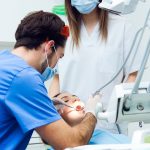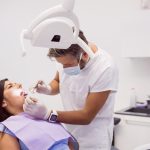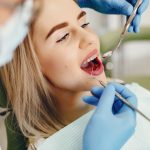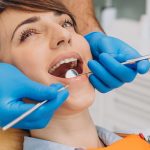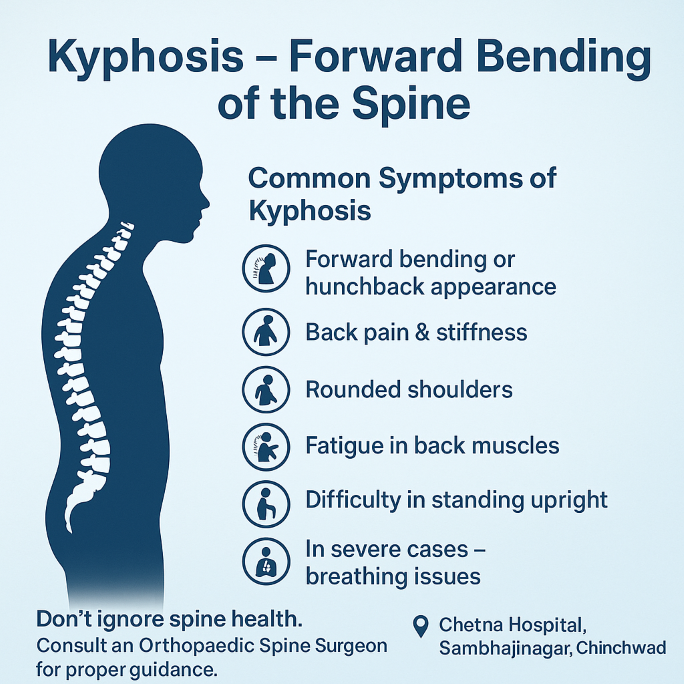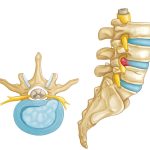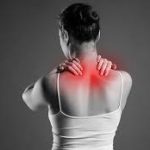The human spine is a marvel of natural engineering, designed to provide both stability and flexibility. It allows us to stand upright, bend, twist, and carry out our daily activities with ease. Normally, the spine has natural curves that help absorb shock and maintain balance. However, when these curves become exaggerated, it can lead to postural and health issues. One such condition is Kyphosis, often referred to as the forward bending of the spine or a “hunchback” posture.
Kyphosis can affect people of all age groups, but it is more commonly observed in older adults due to degenerative changes in the spine. Early recognition of its symptoms is essential, as it can help prevent progression and reduce complications. Let us explore what kyphosis is, why it occurs, and what symptoms patients should watch out for.
What is Kyphosis?
Kyphosis is a spinal condition where the upper back develops an exaggerated outward curve. This leads to a forward-rounded posture, giving the appearance of a hunch or hump. While the thoracic spine (mid to upper back) naturally curves outward, a curve greater than 50 degrees is considered abnormal and is classified as kyphosis.
Kyphosis is not just a cosmetic concern; it can affect spinal function, lead to pain, and in severe cases, interfere with breathing and mobility.
Causes of Kyphosis
The causes of kyphosis vary depending on the type and the age group affected. Some common causes include:
- Postural Kyphosis
- The most common type, especially in adolescents and young adults.
- Caused by slouching, poor posture, or prolonged sitting with a rounded back.
- Usually flexible and correctable with lifestyle modifications.
- Congenital Kyphosis
- Present at birth due to abnormal spinal development.
- May worsen as the child grows and often requires medical or surgical correction.
- Scheuermann’s Kyphosis
- Found in teenagers due to abnormal growth of the vertebrae, which wedge forward.
- Leads to a stiff, more pronounced curve compared to postural kyphosis.
- Age-related / Osteoporotic Kyphosis
- Common in older adults due to weakening of bones from osteoporosis.
- Compression fractures in the vertebrae contribute to a stooped posture.
- Degenerative Kyphosis
- Caused by age-related wear and tear of the spine, discs, and joints.
- Other Causes
- Spinal infections, tumors, or neuromuscular conditions like muscular dystrophy can also lead to kyphosis.
Symptoms of Kyphosis
The symptoms of kyphosis vary from mild postural changes to severe physical discomfort and functional limitations. Some people may notice the condition visually, while others experience pain and difficulty with movement.
Here are the common symptoms of kyphosis:
1. Forward Bending or Hunchback Appearance
- The most noticeable sign is a visible forward rounding of the upper back.
- This rounded posture becomes more evident when standing or walking.
2. Back Pain and Stiffness
- Many patients complain of persistent pain in the mid or upper back.
- Stiffness is common, especially after long periods of sitting or standing.
3. Rounded Shoulders
- Shoulders tend to roll forward, further exaggerating the hunchback posture.
4. Fatigue in Back Muscles
- Due to abnormal alignment, back muscles have to work harder to maintain posture.
- This leads to frequent tiredness, especially after physical activity.
5. Difficulty Standing Upright
- Severe kyphosis can make it challenging to straighten the back fully.
- Patients may struggle with maintaining balance.
6. Breathing Issues
- In advanced cases, the excessive curve compresses the chest cavity.
- This may restrict lung expansion and cause shortness of breath.
7. Reduced Mobility and Flexibility
- The condition can limit spinal flexibility, making bending or twisting difficult.
8. Neurological Symptoms (in severe cases)
- If spinal nerves are compressed, symptoms like numbness, weakness, or tingling in the legs may occur.
Impact of Kyphosis on Daily Life
Kyphosis affects more than just appearance. Its physical and psychological impact can significantly influence a person’s quality of life.
- Physical Impact: Persistent back pain, reduced flexibility, and breathing difficulty can make simple activities like walking, climbing stairs, or exercising challenging.
- Emotional Impact: Visible hunchback posture may lead to low self-esteem, social withdrawal, or body image concerns, particularly in teenagers.
- Functional Limitations: Severe kyphosis can interfere with daily tasks such as driving, cooking, or even dressing.
When to Consult a Doctor
Many people ignore mild postural changes, assuming they are harmless. However, kyphosis should not be neglected. Consult an orthopaedic spine surgeon if you notice:
- A visible hunch or curvature in the upper back.
- Persistent back pain that doesn’t improve with rest.
- Stiffness and muscle fatigue.
- Difficulty in standing upright or maintaining balance.
- Breathing difficulties or chest tightness.
Importance of Early Detection
Early detection of kyphosis allows for better management. In children and adolescents, mild kyphosis can often be corrected with posture training, physiotherapy, and exercises. In adults, early medical advice can prevent worsening of symptoms and reduce complications. Severe cases may require bracing or surgery, but timely consultation can minimize the need for invasive treatments.
Conclusion
Kyphosis is more than just a cosmetic spinal condition; it can impact physical health, mobility, and quality of life. Recognizing its symptoms early—such as forward bending of the spine, back pain, fatigue, and breathing issues—is the first step toward proper management.
Maintaining good posture, strengthening back muscles, and seeking medical attention when symptoms appear are key to preventing complications. If you or someone you know shows signs of kyphosis, consulting an orthopaedic spine surgeon can help in accurate diagnosis and effective treatment.
👉 Don’t ignore spine health. Your spine supports your body every day—take care of it before small changes lead to bigger problems.

